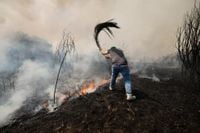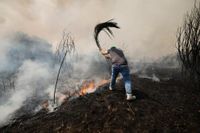Spain has endured a summer for the record books in 2025, with meteorologists and climate experts sounding the alarm as temperatures soared, wildfires raged, and drought gripped much of the country. According to Spain’s national weather agency AEMET, the average temperature between June 1 and August 31 reached 24.2°C (75.5°F)—the hottest since official records began in 1961. This figure edges out the previous record, set just three years prior in 2022, by a slim but significant 0.1°C. It also stands a striking 2.1°C above the 1991-2020 seasonal average, underlining a relentless upward trend that shows little sign of slowing.
“These summers of 2022 and 2025 are a trailer – or spoiler – for what could happen in the middle of the century. One in every three days this summer we have been under a heatwave,” AEMET spokesperson Rubén del Campo told Reuters. His words echo a growing consensus among climate scientists: what once seemed exceptional is fast becoming the new normal.
Spain’s 2025 summer was not just hot—it was unrelenting. The country experienced 33 days of officially declared heatwaves, with one particularly brutal stretch in August lasting 16 days, the most intense on record. During that period, temperatures in the south soared above 45°C (113°F), peaking at a searing 45.8°C (119.3°F) in Jerez de la Frontera on August 17. In inland parts of Galicia, one of the regions hardest hit by wildfires, average temperatures were around 3°C higher than normal.
The consequences of this sustained heat were felt far beyond thermometers and weather charts. Spain’s countryside burned as never before. Wildfires consumed a record 382,000 hectares (944,000 acres), surpassing the previous high of 306,000 hectares set in 2022. Across the European Union, more than 1.03 million hectares—nearly 4,000 square miles—were scorched during the summer, according to the European Forest Fire Information System. The toll was not just ecological: power demand surged as people sought relief, crops wilted in the fields, and authorities issued repeated health warnings to protect the vulnerable from dangerous heat levels.
The impact of these fires was visible not only on the ground but in the atmosphere. Data from the Copernicus Atmosphere Monitoring Service (CAMS) showed that wildfire carbon emissions in Spain rose almost vertically on monitoring charts during the first two weeks of August, overtaking all previous years in their dataset dating back to 2003. This surge in emissions adds yet another feedback loop to the climate crisis, as fires themselves become a source of greenhouse gases that further warm the planet.
While the summer heat was headline-grabbing, the lack of rain may have been just as consequential. Rainfall was well below average in much of the country, particularly in the northwest, where wildfires caused the most devastation. Drought conditions worsened in already parched regions, compounding the stress on agriculture, water supplies, and natural ecosystems. The outlook for the coming months offers little respite: AEMET has forecast that autumn will also be unusually warm, especially in the north and east of the Iberian Peninsula, the Balearic Islands, western Spain, and the Canary Islands. Drier-than-usual conditions are expected to persist, raising concerns that the cycle of heat and drought may continue into the next season.
Spain’s climate trajectory is especially alarming in a broader context. The Mediterranean region is heating up 20% faster than the global average, according to the United Nations. Europe as a whole has been warming at twice the global rate since the 1980s, the European Union’s Copernicus Climate Change Service reports. Spain itself has already warmed by more than 1.5°C compared to pre-industrial levels, placing it among the most climate-vulnerable countries in Europe.
The Spanish government is taking some steps to prepare for what lies ahead. In a move that underscores the urgency of the crisis, officials recently announced that lessons on floods, wildfires, earthquakes, and volcanic eruptions will become compulsory for children as young as three. The aim is to equip the next generation with the knowledge and skills they’ll need to navigate an environment increasingly shaped by climate extremes.
But adaptation alone, experts warn, will not be enough. Scientists are unequivocal: without steep cuts in global greenhouse gas emissions, Spain will face even longer and hotter summers, with mounting impacts on health, agriculture, and ecosystems. The main driver of climate change, they note, is the burning of fossil fuels such as gasoline, oil, and coal—a reality that demands urgent action both domestically and internationally.
The 2025 summer’s toll was not limited to Spain. The extreme heat and fires were part of a wider pattern across Europe. The continent as a whole endured its warmest summer on record in 2024, and 2025 saw Britain experience its hottest summer since records began in 1884. Countries around the world are grappling with similar extremes, as global warming accelerates and pushes weather patterns into uncharted territory.
For Spain, the numbers paint a stark picture. Nine of the ten hottest summers on record have occurred in the 21st century. The trend is clear and, if anything, appears to be accelerating. Power grids, health systems, and rural communities are all being tested as never before. The cost—in lives, livelihoods, and landscapes—is mounting.
“Spain would need to adapt to hotter summers while continuing to contribute to the global effort to curb climate change by reducing emissions of greenhouse gases,” del Campo said. It’s a challenge that will require both immediate action and long-term vision, as the country seeks to protect its people, its environment, and its future.
As the embers of another record-breaking summer cool, one thing is clear: Spain is on the front lines of a climate emergency that is reshaping the world. The choices made now—by governments, businesses, and individuals—will determine not just the weather in years to come, but the very fabric of Spanish life.






